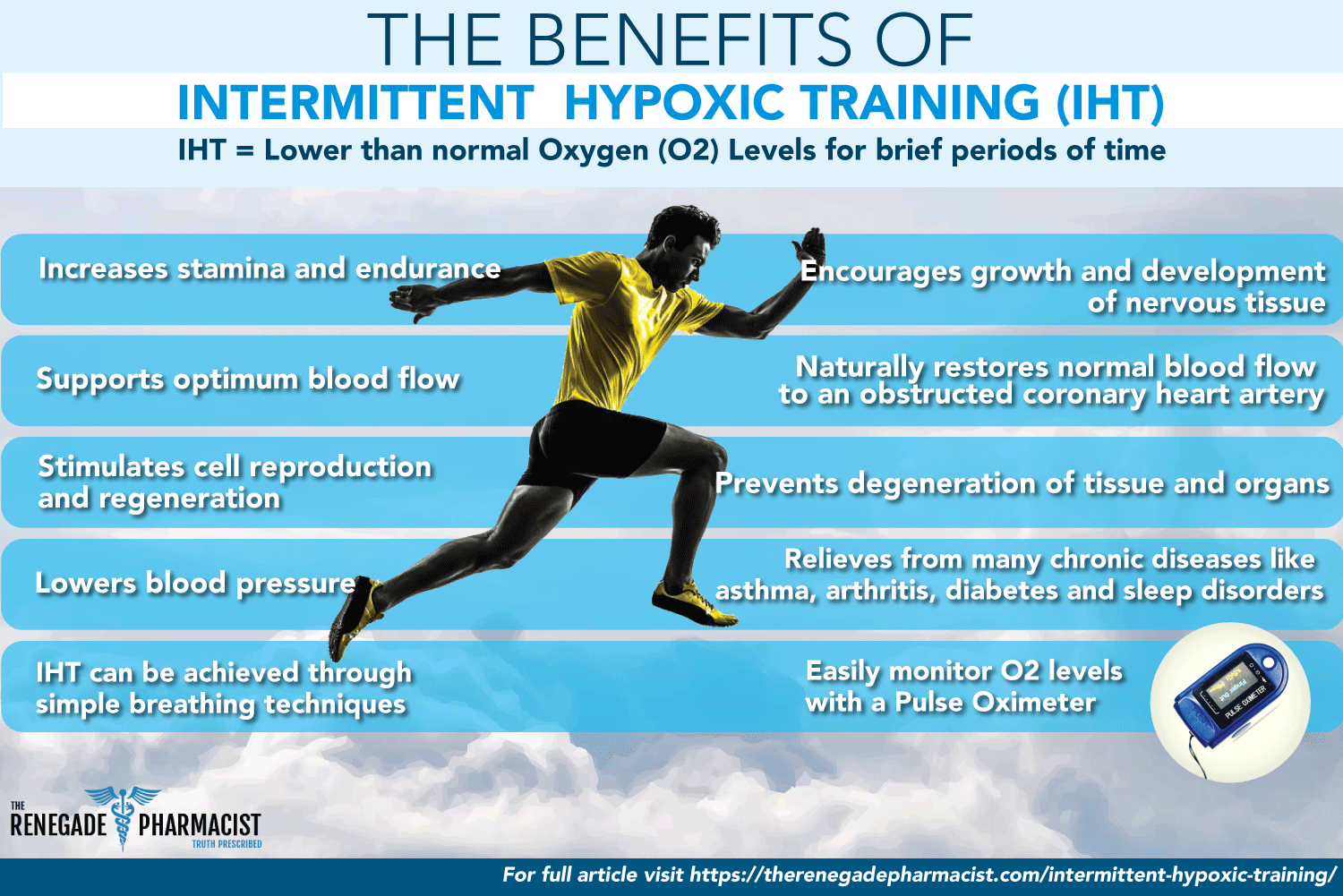Intermittent Hypoxic Training For Improving Fitness, Endurance And Disease Treatment
This article is about the benefits of intermittent hypoxic training for improving fitness, endurance and the treatment of a variety of diseases.
In this article you will learn:
- What is intermittent hypoxic training.
- What are the benefits of intermittent hypoxic training.
- What is the current science that supports intermittent hypoxic training.
- What is the safest and best way to do intermittent hypoxic training.
What Is Intermittent Hypoxic Training?
Intermittent hypoxic training was first developed in the 1930’s by the Soviet Union. It is a method to improve human performance by way of adaptation to reduced oxygen for brief periods of time.
Much like mechanism behind the benefits of intermittent fasting the positive stress response triggered leads to better health and wellbeing.
Intermittent hypoxia produced by intermittent hypoxic training is defined as repeated episodes of hypoxia with intervening periods of normoxia (normal breathing). An IHT session consists of an interval of several minutes breathing hypoxic (low oxygen) air, alternated with intervals breathing ambient (normoxic) or hyperoxic air. This procedure is repeated over a 45- to 90-minute session per day, with a full treatment course taking three to four weeks.
Standard practice is for the patient to remain stationary while breathing hypoxic air via a hand-held mask. The therapy is delivered using a hypoxicator during the day time, allowing the dosage to be monitored. Biofeedback can be delivered using a pulse oximeter.
The actual durations used in different experimental studies vary widely, with hypoxia periods ranging from 3 to 90 min.
Intermittent Hypoxic Training Benefits
Intermittent hypoxic training has been used to try to improve performance in sports. Intermittent hypoxic training (IHT) protocols that administer different doses of intermittent hypoxia have been also been used in a number of health conditions.
In the 1970s Russian scientists trying to improve athletic performance of athletes produced numerous studies identifying the many benefits of intermittent hypoxic training.
Some of these health benefits include:
- Increased stamina and endurance.
- Lower blood pressure.
- Formation of natural ‘heart bypasses’ called coronary collaterals.
- Improved blood flow to muscles and tissues.
- Increased efficiency of mitochondria leading to less risk of oxidative stress, degenerative disease and aging of cells.
- Increased growth hormone levels.
- Relief from asthma, arthritis, diabetes, sleep disorders and other chronic diseases.
- Activation of stem cells leading to lower inflammation, cell repair, growth and even neurogenesis.
The benefits of intermittent hypoxic training are shown when blood saturation of oxygen drops below 90% for 1-3 minutes. Even very brief exposure to hypoxia for even just 15-30 seconds has been shown in studies to give some benefits.
Intermittent Hypoxic Training Methods
For the last 50 years scientists have been studying the effects of hypoxia and have tried various methods of inducing it. It is now a well recognised therapeutic healing modality called ‘Intermittent Hypoxic Therapy’
- Hypobaric chambers
- Quick ascent to high altitudes for short durations.
- Normobaric hypoxic gas mixtures. Using commercially available “Hypoxicators” are instruments that deliver a hypoxic gas mixture containing 10% oxygen. This mixture is called “HGM-10.”Intermittent Hypoxia Therapy
- Nisshesha Rechaka Kumbhaka Pranayama – This is a breathing technique from pranayama, the ancient indian system of breathwork that involves holding your breath after expiring all the air from your lungs.
- Soma Awakening Breath Protocol – Kumbhaka Pranayama if not done properly can be difficult and not very pleasant and so you should always be trained by a qualified instructor. Soma Awakening is a protocol designed to give you the correct dose of intermittent hypoxic training over 21 days using a safe, effective but fun method that combines the benefits of meditation and therapeutic music with breathwork. Qualified instructors will teach you exactly the right way to produce intermittent hypoxia using breathwork, that would save you a lot of money on expensive machines and devices. Get the free training here
Nisshesha Rechaka Kumbhaka Pranayama
The ancient yogi’s must have instinctively realised the benefits of intermittent hypoxia as they developed a safe and natural method of intermittent hypoxic training that’s as simple as holding your breath…
Nisshesha Rechaka is a breathing technique from pranayama that involves holding your breath after expiring all the air from your lungs to produce a drop in blood oxygen levels. Intermittent hypoxia begins to happen at around 1-1:30min of holding your breath. An experienced practitioner can maintain a state of hypoxia for at least 2-3 mins that mimics the effects produced by hypoxic chambers and hypoxicators.
Dr P Malshe at the Antar Prakash Centre for Yoga, tested different varieties of Pranayama for their efficiency in producing hypoxia using a pulse oximeter.
They recorded the SpO2 during different breathholding techniques.
They discovered that a particular sequence ‘Bhastrika followed by Nisshesha rechaka’ is very efficient in producing hypoxia. This is simply ‘hyperventilation followed by breath holding in full expiration’.
The physiological explanation is as follows: The hyperventilation washes out carbon dioxide which at particular concentrations signals your brain to breathe. Once that is done, the breath can be held for a longer duration.
It is the pranayama technique that creates hypoxia the fastest and breath holding called Kumbhaka in pranayama is one of the most revered techniques for controlling energy in your body.
True yogis speak of the importance of slowing down your breath in order to experience optimum health and mental clarity.
‘A Yogi measures the span of his life not by the number of years but by the number of his breaths…
When the breath is expired, it is Rechaka, the first kind of Pranayama. When the breath is drawn in, it is the second, termed Puraka. When it is suspended, it is the third kind, called Kumbhaka. Kumbhaka is retention of breath. Kumbhaka increases the period of life.’ Sri Swami Sivananda
Here is an article that goes deeper into the science and benefits of IHT using Nisshesha rechaka.
Soma Breath
Soma Awakening is inspired by the most revered pranayama technique called Nishessha Rechaka Kumbhaka and the ancient ritual of Soma that has over 50,000 references to it in the ancient text, Rig Veda, that is the basis of modern day Hinduism and the Vedic philosophy that yoga originates from.
Using a combination of scientifically proven breathwork techniques, rhythmical and euphoric music, guided meditation and imagery I have developed a remarkable process for reaching heightened states of consciousness and ecstatic bliss. It has even been described as a ‘psychedelic orgasm on DMT’ by a modern shaman.
Through a more therapeutic variation of this same process, the layers of your mask peel away and reveal your true nature. This is similar to the way early pioneers of psychedelic therapy, such as Timothy Leary did using LSD to treat various problems conventional forms of therapy could not touch.
You connect deeply to who you really are. Through this awareness comes the path to truth.
Through truth you learn exactly the difference between what is good for you and what is no longer serving you anymore.
You can remove negativity and attachment to the past, fully embrace the present and be at your very best every single day.
This is the evolution of Soma Breath.
To get the best results with Soma Breath, we recommend you actually practice and master intermittent hypoxic training with the guidance of a Soma Breath Coach.
That’s why SOMA Breath was created.
Every Sunday we host a webinar and live Soma journey (you can also watch a previous replay on the same link) where we discuss in detail how to do these techniques, and much more, to increase the quality of your life, trigger self-healing and accelerate the achievement of your goals.




Leave A Comment